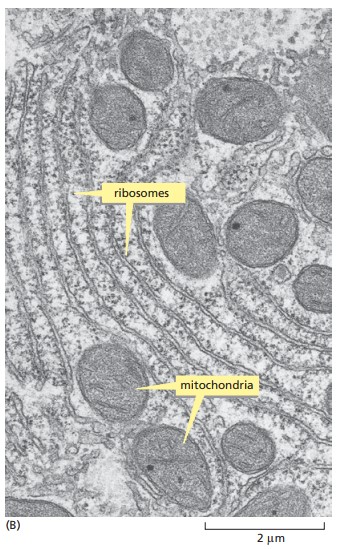
We might describe the nucleus as the cell’s command center. If we take this metaphor, then we might extend it to ribosomes, which would be the machines that carry out the nucleus’s commands (Taylor et al. 2018). In other words, they are the cell’s protein synthesis machinery (Mason et al. 2014). As explained in a previous post, the nucleolus es that part of the nucleus where the components of ribosomes are assembled.
Ribosomes are large macromolecular complexes composed of 80-90 individual proteins and RNA molecules (Alberts et al. 2014). They are cellular components, and they use the instructions from the nucleus, which are written in messenger RNA (mRNA), to build proteins. Those cells that make many proteins have also a great number of ribosomes (Taylor et al. 2018).
THE CELL’S PROTEIN SYNTHESIS MACHINERY
Even though the amino acid sequence of each protein in the cell is encoded in the DNA of the cell’s nucleus, proteins are not synthesized there (Mason et al. 2014). Protein synthesis is associated with large RNA-protein complexes outside of the nucleus, which are the ribosomes defined above.

Each ribosome is comprised of two sub-units: each of which is a combination of ribosomal RNA (or rRNA) and proteins. Both subunits join to create a functional ribosome only when they are actively synthesizing proteins (Mason et al. 2014). To execute this intricate process, ribosomes require two more forms of RNA:
- Messenger RNA (mRNA): mRNA carries coding information from the cell nucleus’s DNA.
- Transfer RNA (tRNA): tRNA carries amino acids.
Ribosomes use the information in mRNA to direct the synthesis of a protein (Mason et al. 2014).
These complex RNA-protein macromolecules are found in all cell types from all three domains of life (Bacteria, Archaea, and Eukarya). This is why they are thought of as “universal organelles.” Life is protein-based, and ribosomes are the factories that make proteins (Mason et al. 2014).
TYPES OF RIBOSOMES
One can find ribosomes in two different parts of the cell. Depending on where they are, we might give them a specific name:
- Free ribosomes: Those suspended in the cytosol (Taylor et al. 2018). They synthesize proteins that are found in the cytoplasm, nuclear proteins, mitochondrial proteins, and proteins found in other organelles not derived from the endomembrane system (Mason et al. 2014).
- Bound ribosomes: Those attached to the outside of the endoplasmic reticulum or nuclear envelope (Taylor et al. 2018). They synthesize membrane proteins, proteins found in the endomembrane system, and proteins destined for export from the cell (Mason et al. 2014).

Both can work in either location and are structurally identical, and they depend on the protein they are producing (Taylor et al. 2018). As asserted by Mason et al. (2014), they serve as sites of protein synthesis.

The picture on the left depicts a small region of the cytoplasm at higher magnification. the smallest structures that are observable are free ribosomes (Alberts et al. 2014).
SUMMARY
Ribosomes are complex macromolecules comprised of two subunits, each one made of ribosomal RNA and proteins. Ribosomes are the factories that make proteins within a cell and since life is protein-based, ribosomes are found in all three domains of life. Also, to synthesize proteins, they need mRNA (which carries information from the DNA) and tRNA (which carries amino acids).
Ribosomes can be located inside the nuclear envelope (in such a case known as bound ribosomes) and within the cytosol (which we call free ribosomes). Both are structurally identical but produce different proteins depending on where they are located.
REFERENCES
Alberts et al. (2014). Essential cell biology. 4th edition
Mason et al. (2014). Biology. 11th edition
Taylor et al. (2018). Campbell biology concepts & connections. 9th edition

DNA is often described as the core of life, but ever since I first learned about ribosomes, I’ve felt that they might be the real core. The RNA world hypotheses for the origin of life only strengthens that feeling.
LikeLiked by 1 person
Indeed. There are other theories like the hydrothermal vent one or something like that, but I’d like to explore each one of them step by step with you guys in individual posts
LikeLiked by 1 person
Looking forward to those posts!
LikeLiked by 1 person